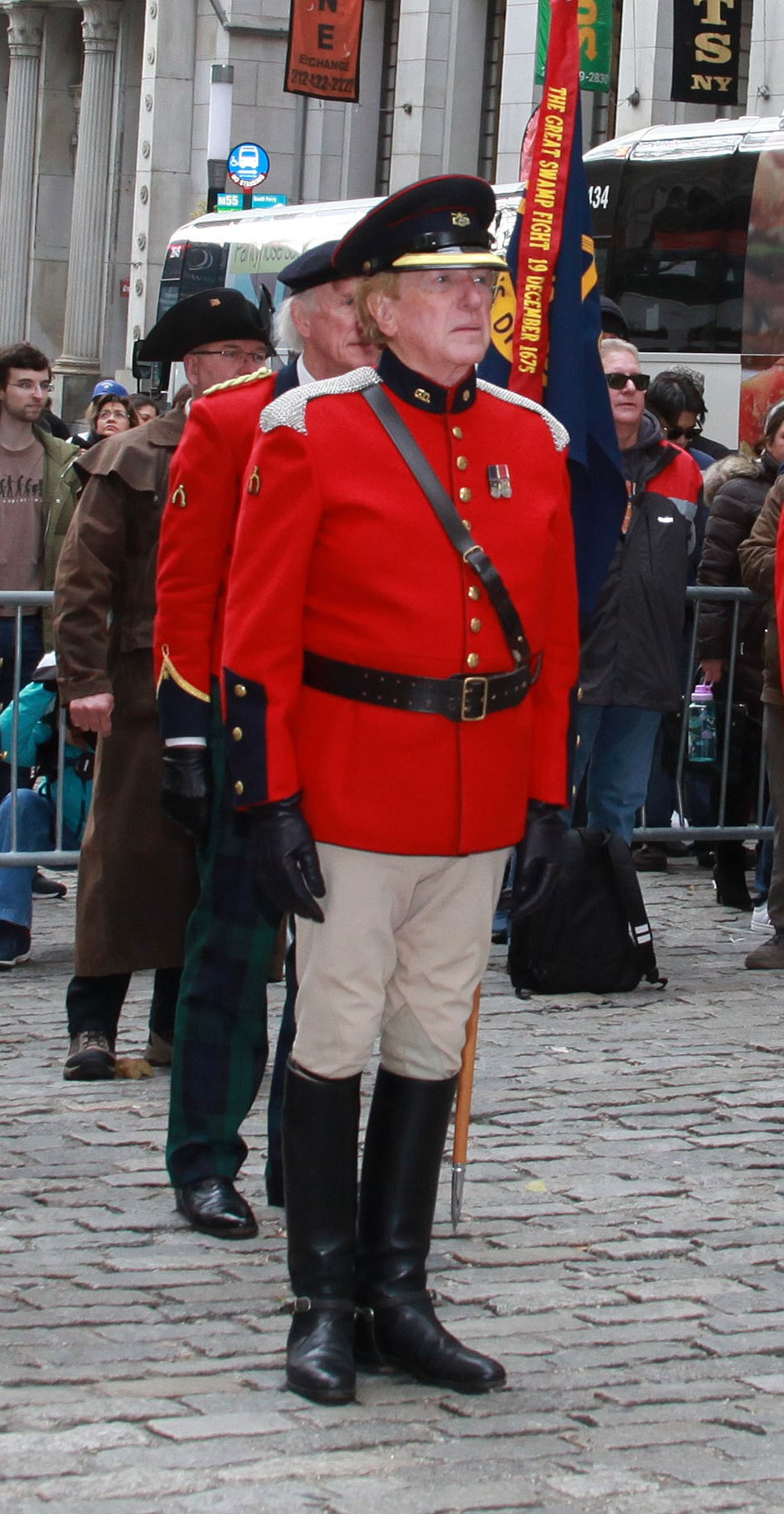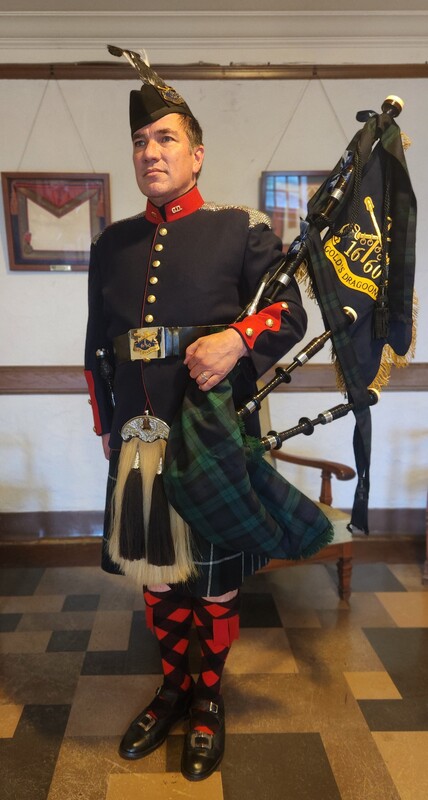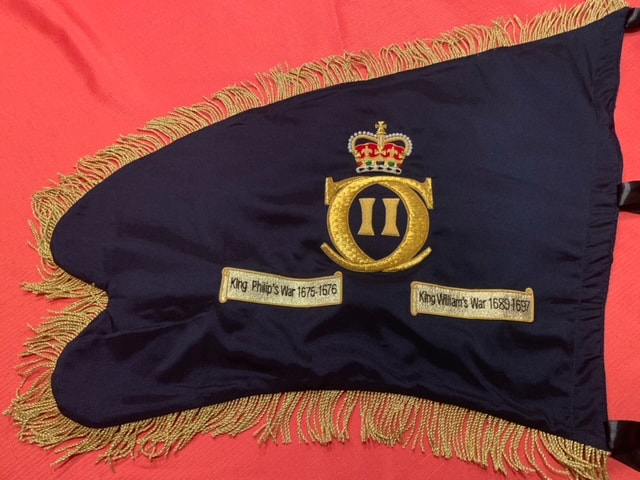|
Early History
At the time of his death of old age in March, 1693 Major Nathan Gold, the founder of Gold's Dragoons, was believed to be the richest man in Fairfield County. He had a long and productive life as a soldier, judge, merchant and politician - yet no town or road is named after him, nor is a portrait believed to exist. Today he is chiefly remembered for raising a small troop of horse in Fairfield County, Ct., in 1657. King Charles II was restored to the English throne in 1660 and all colonial troops passed under Royal control. In 1662 the troop was entered into the colonial militia, under the seal of King Charles II with the adoption of the Connecticut Colony Charter, to which Nathan Gold was a signatory. Their mission was to protect against Dutch encroachment from the west and Pequot Indian warriors on the Connecticut frontier - in those days not too many miles from the coast of Long Island sound. For more information on the role of Nathan Gold click on the link #3 - Major Nathan Gold, of the old town of Fairfield, Conn : a summary ... - Full View | HathiTrust Digital Library and the actual charter language of the original document click on https://avalon.law.yale.edu/17th_century/ct03.asp According to the recorded history of the Ancient and Honorable Artillery Company of Boston, that unit, chartered in 1634, is the oldest chartered military unit in the Western Hemisphere. According to the records of the Centennial Legion, Gold's Dragoons, chartered in 1662, is the second oldest chartered military unit and - as the AHAC was infantry - Gold's Dragoons is the oldest cavalry unit in the Western Hemisphere. As was customary in the seventeenth century, the troop was named after the officer who raised it. All adult males were liable for home defense at the time but a mounted unit had its own prestige and Nathan Gold would have financed part of the expenses, appointed lieutenants, cornets and sergeants, determined styles of uniforms and type of weapons to be carried. Far from a sleepy home guard, Gold led his dragoons in two colonial conflicts; King Philip's War against the Wampanoag sachem Metacom in New England (1675-1676) and also King William's War (1689-1697) against the French and their Indian allies along the borders of New England and New France. In King William's War, the troop would serve as far north as Schenectady in 1690 to avenge the massacre of English settlers and took an active part in the Quebec expedition later that year. The Gold’s Dragoons troopers of 1660's were essentially mounted infantry using horses to transport a man to a conflict where he would fight on foot. The illustration above shows typical British dragoons of the period forming a skirmishing line. Dragoons were perfect for the Indian frontier. They operated in wooded areas ideal for ambush, where the fighting ax of the present day Gold’s Dragoons guidon and mess dress collar dog was a better weapon for close quarter battle than any lance or saber. By order of the Connecticut Council to Major Gold, dated November 22, 1675, the first ten troopers of Gold's Dragoons were ordered to hang “hatchets” from their belts, rather than swords. In memory of that order, the Master of Horse, when mounted on parade, has a hatchet attached to his saddle. By the end of King Philip’s War Nathan Gold was 67 years old, quite an old man by the standards of the time. He had led his troopers through two wars and, while his political career continued to flourish, his soldiering days were over. His son was later appointed Lieutenant Governor of the Colony of Connecticut and the troop will have fought in the Revolution as militia under Nathan Gold's great-grandson, Col. Abraham Gould (the family used both spellings), who was killed at the Battle of Ridgefield in 1777, but we have not been able to confirm this (his tombstone is featured top left). If it is true, Gold’s Dragoons then disappears from public record for almost 150 years. A descendant of Nathan Gold was the 19th Century financier Jay Gould, who had no connection with the troop. Re-raising Gold's Dragoons As war clouds gathered in the early 1930s the members of the Fairfield County Hunt (hunt uniform top left) determined to follow the example of other local horse owners and offer their services to the State of Connecticut as a mounted home guard. They were to supply their own horses but were otherwise uniformed, armed and equipped by the State. When the gentlemen of Fairfield chose to organize and name their new unit, they reached back to the last century and re-raised Gold’s Dragoons in 1932, confirmed by state charter in 1933, using their hunt colors of scarlet, blue and gold as the basis for their scarlet drill uniform, and adding the chain mail epaulettes of British Army cavalry regiments (middle left). For the ceremonial parade uniform of the troop trumpeter (below left) they "reversed" the facings to make the jacket blue with the collar and cuffs scarlet, as was normal military practice. That was the actual uniform of "Bud" Brennan, then a 15 year old trumpeter. He was the last survivor of the troop when he died ten years ago. We have revived the exact copy of the scarlet 1930s trooper's parade uniform, which can be worn in place of the mess dress. Our pipers are musicians like the trumpeter and so also wear the reversed colors on the parade uniform. Below, left is duty piper, Mick Burgess, in the parade uniform. There followed years of nighttime patrols, formation riding drills, weekend horse shows and – no doubt – some serious drinking in the bar of the Fairfield County Hunt club. The “image of war without the guilt” of their foxhunting passion was to find a new meaning in a real war. "...Gold's Dragoons were well-placed young men who loved horses, certainly as much as they loved their wives. They dressed themselves in beige britches, scarlet jackets, chains of silver epaulets, wide-brimmed hats with chin straps, black leather boots, and dazzling spurs. Each Saturday they met on Greenfield Hill and rode about in the imitation of drills and cavortings of cavalry..." "The Other Side of Loneliness", by Ned O'Gorman, copyright 2006. The troop attracted many veterans of the Great War, including Paul Daly, West Pointer, and Jock Hanchet-Taylor, who was British and had served in The Black Watch regiment. Jock was the commander from 1936 until 1940 when he resigned and headed north to join the Royal Canadian Air Force. His service to the troop is remembered by the wearing of the Black Watch trews as part of our uniform. A truly exotic member was Cossack general Konstantin Agoeff, who fought under the Czar and later commanded a division of White Russian troops against the Bolsheviks. His equestrian feats were legendary. In 1942 troop was converted into motorized cavalry two months after Pearl Harbor and were recommended for enrollment in the State Guard Reserve by the Connecticut Adjutant General. In June they mounted their armored cars, with live ammunition, locked and loaded, and headed up Route 1 to attack a group of Germans who had landed further up the Connecticut coast. This turned out to be a training exercise gone awry, so they may have promptly returned to the bar of the Fairfield County Hunt Club to celebrate their great adventure. We hope to memorialize their trip in a road rally on a future date. As 1942 advanced the troop was overtaken by events and all members joined the United States national armed forces. They were to return in 1946 as veterans and established their mess dinners again, which we continue today. No former member of Gold’s Dragoons better exemplifies their patriotism and service than Captain Michael Daly. He joined the army in 1942, landed at Omaha Beach, won a battlefield commission and received the Medal of Honor, fighting as an infantry officer in the closing days of the war. Mike Daly died in 2008 and is greatly missed. Working with Ken Powers and Bud Brennan, he had been instrumental in reviving the annual dinners at the Fairfield Hunt club and attended all of them until prevented by ill health, at which point he demanded a prompt report of each dinner from the secretary/treasurer. He relished the thought that the spirit of Gold’s Dragoons lived on and it is to him, and the men he served with, that we dedicate our annual Nominating Dinner. Captain Daly is remembered by the Michael Daly Memorial Cup which is awarded each year to the member of Gold's Dragoons with the highest individual score in the annual spring sporting clays shoot. Current History Gold's Dragoons is fraternal society of around 200 members. We operate as a 501(c)(7) corporation and under bye-laws that are available upon request by any member in good standing. We engage in many events and pursuits in keeping with our cavalry past, including polo, shooting sporting clays, historical courts martial - and enjoy reciprocity with a number of societies with a similar ethos. Our spiritual home remains the clubhouse of the Fairfield County Hunt Club where we were re-raised in the 1930s. With the exception of the Second World War, we have held our annual dinners there for the past ninety years. In the summer every year we offer a polo match at the Fairfield Hunt Club with free admission to the public, to raise funds for our official military charity, The Equus Effect. This is the same polo field that Gold's Dragoons polo teams have played on for close to a hundred years. In 2019 Gold's Dragoons was awarded a battle streamer by the Society of Colonial Wars for The Great Swamp Fight of 1675, a battle in which the troop served. Three of our current members are direct descendants of troopers of Gold's Dragoons, all of whom were killed in the battle. This streamer is now attached to the troop guidon and is a fitting update for a troop that has served the people of Connecticut for over 350 years. Members may purchase and wear the traditional mess dress of Gold's Dragoons for social occasions. We also have three parades a year and members may purchase and wear the identical red parade jacket worn by troopers in their parades over ninety years ago, illustrated above left. Members are under no obligation to purchase either uniform but they are a direct link to the active years of Gold's Dragoons as an active cavalry unit and link to the 350 years of Gold's Dragoons in defending the State of Connecticut. |













